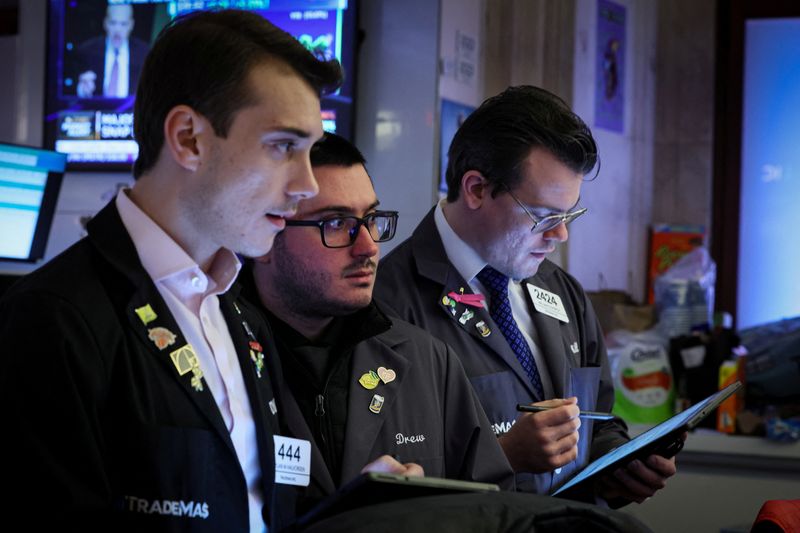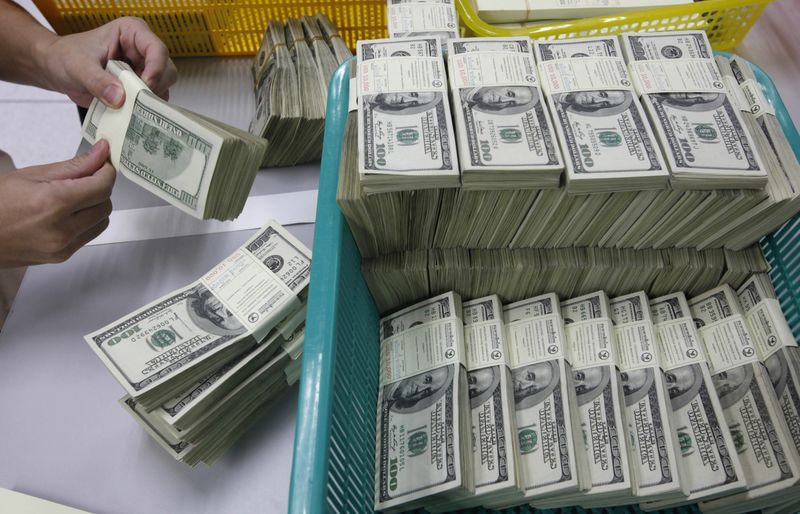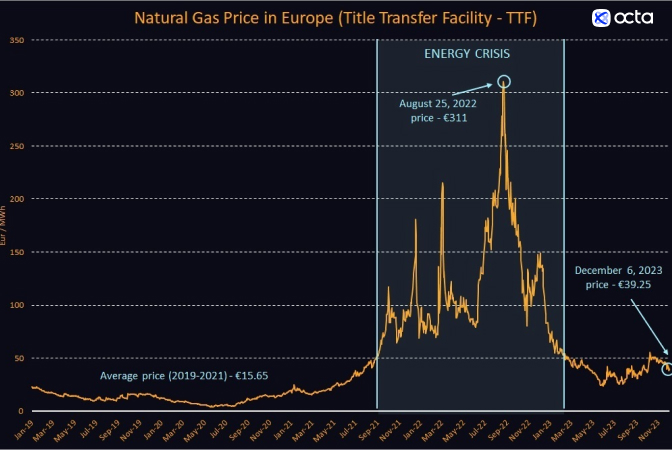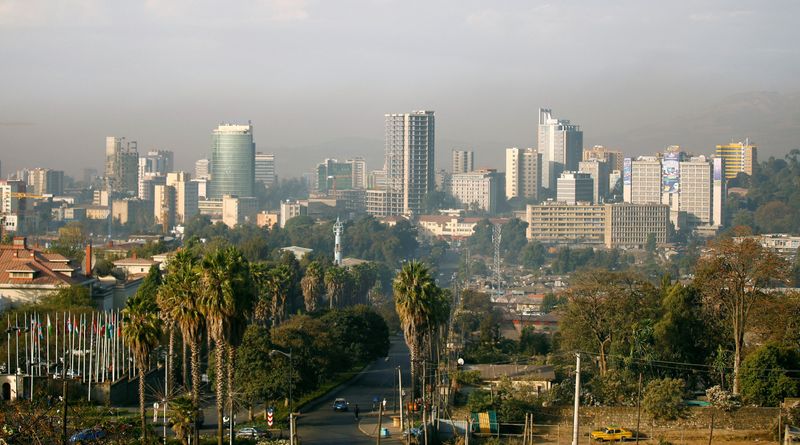Select Language

MEXICO CITY (Reuters) - Mexican and U.S. officials have agreed to work together more closely to tackle record migration at their shared border, the countries' governments said in a joint statement on Thursday, a day after high-level talks on stemming record numbers.
Following a visit to Mexico by U.S. Secretary of State Antony Blinken, the countries said they would seek to strengthen a sponsorship initiative for Venezuelan, Cuban, Nicaraguan and Haitian migrants and look to tackle the root causes of migration.
The delegations, who are set to meet again in Washington next month, also discussed regularizing the situation of beneficiaries of the U.S. Deferred Action for Childhood Arrivals (DACA) program - the so-called Dreamers who were brought into the country illegally as children - and long-time undocumented Hispanic migrants living in the United States.
The talks came after the U.S. temporarily shuttered some border crossings to redeploy agents toward enforcement, sparking a trade slowdown and criticism by Republicans of the Biden administration's border policies. Immigration and the border are expected to be top issues in the U.S. 2024 elections, where President Joe Biden, a Democrat, is running for a second term.
Earlier Thursday, Mexican President Andres Manuel Lopez Obrador said the two parties had agreed to keep border crossings open after the temporary closures.
"This agreement has been reached, the rail crossings and the border bridges are already being opened to normalize the situation," Lopez Obrador told a morning press conference.
Lopez Obrador said Wednesday's meetings with the U.S. delegation were "direct," and he praised the Biden administration's relationship with Mexico.
'FAITH IN GOD'
More than half a million migrants this year crossed the dangerous Darien Gap jungle connecting South America with Central America – double last year's record – with many fleeing crime, poverty and conflict to seek better prospects in the United States.
The latest of a series of caravans of migrants and asylum seekers, many with small children, is slowly walking across southern Mexico, heading towards the U.S border. Lopez Obrador estimated that the caravan counts some 1,500 people but some activists and local media have put the figure at 7,000.
"We have to have faith in God," Honduran migrant Marvin Mejias said as he traveled with his son, who has had foot surgery. Mejias said he hoped the governments had reached a deal which would help him enter the U.S. and be able to work there.
Lopez Obrador said the issue of fentanyl, a powerful and deadly opioid that Mexican cartels have been trafficking into the U.S., was "hardly discussed" in Wednesday's meeting.
The United States has been pressing Mexico to do more to combat fentanyl trafficking, while Mexico has been pushing for stronger U.S. controls to prevent U.S. firearms from reaching the powerful cartels.

By Harry Robertson
LONDON (Reuters) - A huge two-month rally in bond prices, powered by expectations that central banks will soon be cutting interest rates, has rescued fixed income markets from an almost unheard-of third straight year of declines.
The U.S. 10-year Treasury yield, the benchmark for borrowing costs globally, has dropped 50 basis points (bps) in December after falling 53 bps in November. Its two-month fall is the biggest since 2008, when the Federal Reserve was slashing rates during the global financial crisis.
ICE BofA's global broad bond market index, which includes government and corporate debt, has rallied roughly 7% over the last two months -- its strongest eight-week period on record, according to LSEG data which goes back to 1997.
The sharp drop in yields, which move inversely to prices, has eased pressure on companies and households as well as housing markets and governments that in October faced the steepest borrowing costs in more than a decade.
It has also been a balm for highly indebted countries such as Italy, where bond yields are poised for their biggest monthly fall since 2013.
HAWKS TURN DOVISH
Central bankers abruptly changed their tone on inflation in December, fuelling investors' rate-cut bets. That followed a blockbuster November, when data showed U.S. and European inflation falling much faster than expected.
"We were surprised by the strength of this rally," said Oliver Eichmann, head of European fixed income at asset manager DWS.
The Fed's Christopher Waller and the European Central Bank's Isabel Schnabel, both previously renowned monetary policy hawks, softened their language in December and acknowledged - in Schnabel's words - a "remarkable" fall in inflation.
The Fed triggered fresh market euphoria when it used its December meeting to say that rate hikes were over. Fed Chair Jerome Powell notably declined to push back against market bets on deep cuts next year, although the Fed's "dot plot" envisaged three 25 bp cuts in 2024, compared to the more than 150 bps priced in by markets.
"That was a surprise," said Jamie Niven, bond portfolio manager at asset manager Candriam. "And it does leave you with the question, what are they seeing that maybe the market isn't?"
The riskier parts of the bond market, increasingly attractive as investors bet on rate cuts next year, have rallied the most.
Italy's benchmark 10-year bond yield is on track to fall more than 75 bps in December, its biggest monthly drop since the euro zone debt crisis in 2013.
Meanwhile, the spread of junk bond yields over benchmark risk-free rates in the United States and Europe has fallen to its lowest level since the second quarter of 2022.
The two-month jump in bond prices has saved the market from the ignominy of a third year in the red, something not seen in 40 years or more, after two down years driven by inflation and rate hikes.
Bond indexes were in negative territory in October as U.S. growth and inflation kept surprising economists, bolstering the case for higher rates for longer.
The ICE BofA broad bond market index is now heading for an annual gain of around 5%.
Not all investors are convinced their luck will hold.
"It's gone too far," said DWS's Eichmann. He expects more "push-back" from central bankers in the new year and fewer rate cuts than priced in by markets.

BEIJING (Reuters) - China's manufacturing activity likely contracted for the third consecutive month, a Reuters poll showed on Thursday, weighed by soft demand for manufactured goods, a reading that would embolden calls for more policy support.
The official purchasing managers' index (PMI) likely was at 49.5 in December from last month's 49.4, according to the median forecast of 24 economists in a poll conducted 22-28 December. The 50-point mark separates growth from contraction.
The world's second-biggest economy has staggered following a feeble post-pandemic recovery, held back by a property crisis, local government debt risks and slow global growth.
The government has in recent months unveiled a series of measures to prop up growth.
Only three of 24 economists expected an expansion of factory activity in December, with the highest forecast reading of 50.5, showed the poll.
New bank lending in China jumped less than expected in November, even as the central bank keeps policy accommodative to lift confidence and spur the recovery.
Ratings agency Moody's (NYSE:MCO) in December slapped a downgrade warning on China's credit rating as property pressures mount.
China will strive to expand domestic demand, ensure a speedy economic recovery and promote stable growth, according to an interim report on the country's 14th five-year plan published by parliament on Wednesday.
The official PMI will be released on Sunday. The private Caixin factory survey will be issued on Tuesday, and analysts expect its reading to slowed to 50.4 from an unexpected expansion reading of 50.7 in November.

By Stephen Culp
NEW YORK (Reuters) -U.S. stocks closed slightly higher in languid trading on Wednesday, with little market-moving news to fuel conviction as the S&P 500 hovered just below bull market confirmation.
The three major U.S. stock indexes oscillated between modest gains and losses throughout the session but finished up for the day. All are on course for monthly, quarterly, and annual gains.
The S&P 500 ended 0.3% below its record closing high of 4,796.56 reached on Jan. 3, 2022. The Dow notched a new record closing high.
"When you have very few catalysts and minimal trading activity you tend to see continuation of the trends," said Chuck Carlson, chief executive officer at Horizon Investment Services in Hammond, Indiana.
"We’ve got three days left of trading in the year," Carlson added. "That means three days left of tax harvesting, three days of portfolio window dressing ... those sort of things can get magnified because of the lack of trading volume."
Reaching a new record close would confirm the bellwether index entered a bull market when it reached the bear market closing trough in October 2022.
"Those kind of milestones are important because they can generate activity for investors who are sitting on the fence," Carlson said.
In the wake of Friday's cooler-than-expected U.S. PCE price index data, bets are firming that the Fed will start issue its first rate cut as soon as March, which is supporting interest rate sensitive shares and giving Wall Street's major indexes an upward bias.
At last glance, financial markets have priced in a 73.9% probability that policymakers will reduce the Fed funds target rate by 25 basis points at the conclusion of their March policy meeting, according to CME's FedWatch tool.
The Dow Jones Industrial Average rose 111.19 points, or 0.3%, to 37,656.52, the S&P 500 gained 6.83 points, or 0.14%, to 4,781.58 and the Nasdaq Composite added 24.60 points, or 0.16%, to 15,099.18.
Among the 11 major sectors in the S&P 500, real estate enjoyed the largest percentage gain, while energy shares, weighed down by falling crude prices, lost the most.
Shares of Bit Digital jumped 18.6% following the bitcoin miner's announcement that it plans to double its mining operations.
Coherus BioSciences rose 23.6% after the U.S. Food and Drug Administration approved its drug delivery device for its infection-fighting treatment.
First Wave BioPharma shares surged 49.6% after the drug developer agreed to sell its inflammatory bowel disease drug to an undisclosed company.
Cytokinetics (NASDAQ:CYTK) soared 82.6% after its experimental heart disease drug met the main goal of late-stage study, putting it on track to compete with a rival treatment from Bristol Myers (NYSE:BMY) Squibb.
Advancing issues outnumbered declining ones on the NYSE by a 1.86-to-1 ratio; on Nasdaq, a 1.46-to-1 ratio favored advancers.
The S&P 500 posted 50 new 52-week highs and no new lows; the Nasdaq Composite recorded 218 new highs and 60 new lows.
Volume on U.S. exchanges was 11.96 billion shares, compared with the 12.67 billion average for the full session over the last 20 trading days.

WASHINGTON (Reuters) - The U.S. will provide up to $250 million in arms and equipment to Ukraine in the final package of aid this year to help Kyiv in its war with Russia, Secretary of State Antony Blinken said on Wednesday.
President Joe Biden has asked Congress to provide another $61 billion in aid to Ukraine, but Republicans are refusing to approve the assistance without an agreement with Democrats to tighten security along the U.S.-Mexico border.
The White House has warned that without the additional appropriation U.S. aid will run out by the end of the year for Ukraine's fight to retake territory occupied by Russian forces since it invaded in February 2022.
Blinken said the latest aid package included air defense munitions, additional ammunition for high-mobility artillery rocket systems, artillery ammunition, anti-armor munitions and over 15 million rounds of ammunition.
Congress has approved more than $110 billion for Ukraine since Russia's invasion, but it has not approved any funds since Republicans took control of the House of Representatives from Democrats in January 2023.

By Koh Gui Qing and Dhara Ranasinghe
NEW YORK/LONDON (Reuters) -World stocks rallied to their highest level in more than a year on Wednesday, while the U.S. dollar hit a five-month low, as expectations mounted that key central banks such as the Federal Reserve will start to cut interest rates early next year.
In line with expectations of lower interest rates, the benchmark 10-year Treasury yield fell to a five-month low, while the two-year Treasury yield tumbled to a low not seen in seven months.
Investor hopes that monetary conditions might be loosening boosted the MSCI's gauge of stocks across the globe by 0.46% to a level not seen since October 2022.
On Wall Street, the Dow Jones Industrial Average added 0.21%, while the S&P 500 and the Nasdaq Composite were flat.
European shares edged up 0.21%, with trade subdued given public holidays across the region on Monday and Tuesday.
Analysts said the main risk for markets was that rates might not fall as fast as expected.
"If global equity markets have one Achilles' heel going into January 2024, it is the expectation that the Fed will be methodically and consistently cutting interest rates throughout the year," said Nicholas Colas, Co-founder of DataTrek Research.
The benchmark 10-year Treasury yield fell to 3.793%, and the 2-year yield retreated to 4.2375%. [US/]
Expectations of rate cuts also dragged on the U.S. dollar, which fell 0.51% against a basket of six major currencies to a level last seen on Jul. 27. [USD/]
The jovial mood in world equity markets and a sluggish dollar lifted the euro by 0.54% to $1.1102, more than a four-month peak.
“If the Fed cuts rates because inflation has come so far down that they don’t want policy to unintentionally tighten ... then that’s probably a good scenario,” said Lou Brien, market strategist at DRW Trading in Chicago.
If they cut because of a weakening economy, however, “then the history is kind of harsh” for the economy and the stock market. “The motivation behind the rate cuts is still unknown and is going to be the most important factor,” Brien said.
Market pricing shows a more than 80% chance the Fed is likely to begin cutting rates next March, according to the CME FedWatch tool, with over 150 basis points of easing priced in for all of 2024.
Oil prices slipped as some major shippers returned to the Red Sea - an area disrupted after Yemen's Houthi militant group began targeting vessels earlier this month.
U.S. crude fell 2.02% to $74.04 per barrel and Brent was at $79.6, down 1.81% on the day.
Maersk shares fell more than 4.5%, and other shipping stocks also declined, giving back part of this month's gains that were driven by expectations a Red Sea traffic halt could boost rates.
In Asia, MSCI's broadest index of Asia-Pacific shares outside Japan rose more than 1% to an over four-month high.
China's November industrial profits posted double-digit gains as overall manufacturing improved, data showed, although soft demand continued to constrain business growth expectations, emboldening calls for more macro policy support.
Japan's Nikkei rallied more than 1%, and Hong Kong's Hang Seng Index rose 1.7% in its first trading day after the Christmas and Boxing Day holidays. Chinese blue chips eked out a marginal gain of 0.35%.
Spot gold added 0.5% to $2,077.39 an ounce [GOL/], while Bitcoin jumped rose 2.08% to $43,393.00.

By Ankur Banerjee
SINGAPORE (Reuters) -The dollar remained under pressure on Wednesday and the euro was close to a four-month peak, as expectations that the Federal Reserve would soon cut interest rates took hold in the market, with thin year-end flows keeping movements limited.
With many traders out for holidays, volumes are likely to be muted until the New Year.
The dollar index, which measures the U.S. currency against six rivals, was at 101.47, just shy of the five-month low of 101.42 it touched last week. The index is on course for a 1.9% drop in 2023 after two straight years of strong gains, driven by first the anticipation of and then the actual hiking of rates by the Fed to battle inflation.
"With little to speak of on the economic calendar for this week between global holidays, we do not expect a large swing in pricing to wrap up this calendar year," analysts at Monex USA said in a note.
The recent weakness in the dollar - the index is set to clock a second straight month of losses - has been the result of the markets anticipating rate cuts from the Fed next year, denting the appeal of the greenback.
Markets are now pricing in a 79% chance of a rate cut starting in March 2024, according to CME FedWatch tool, with over 150 basis points of cuts priced in for next year.
Data showing cooling inflation has emboldened bets of easing next year.
"Disinflation is proving entrenched (and) expectations are for central banks to pivot next year while growth is still trudging along," said Christopher Wong, a currency strategist at OCBC in Singapore.
"This paints a goldilocks market that is favourable for risk proxies."
The Australian dollar and the New Zealand dollar both touched a fresh five-month peak earlier in the session. The Aussie last bought $0.6828, while the kiwi was at $0.6333.
Meanwhile, the euro was down 0.04% at $1.10385, having touched a four-month high of $1.1045 on Tuesday. The single currency is up nearly 3% in the year and is on course for a third straight month of gains, matching the run it had last year.
The Japanese yen weakened 0.14% to 142.58 per dollar and is headed for an 8% drop in the year although the Asian currency has witnessed a bout of strength in recent weeks as traders wager that the Bank of Japan will soon exit its ultra-loose policy.
A summary of opinions at the central bank's Dec. 18-19 meeting showed that BOJ policymakers saw the need to maintain its ultra-easy monetary policy for now, with some calling for a deeper debate on a future exit from massive stimulus.
The summary of opinions was somewhat dovish and showed no sense of urgency to end the ultra-loose policies, according to Saxo strategists.
The likely timing of the end of the policies will be later than what the market is anticipating, the Saxo strategists said in a note.
========================================================
Currency bid prices at 0555 GMT
Description RIC Last U.S. Close Pct Change YTD Pct High Bid Low Bid
Previous Change
Session
Euro/Dollar $1.1041 $1.1043 +0.00% +3.05% +1.1044 +1.1029
Dollar/Yen 142.5600 142.3900 +0.17% +8.69% +142.8400 +142.4500
Euro/Yen 157.41 157.23 +0.11% +12.20% +157.6700 +157.1600
Dollar/Swiss 0.8535 0.8537 -0.01% -7.69% +0.8545 +0.8535
Sterling/Dollar 1.2730 1.2723 +0.03% +5.24% +1.2732 +1.2720
Dollar/Canadian 1.3189 1.3195 -0.06% -2.67% +1.3210 +1.3187
Aussie/Dollar 0.6828 0.6825 +0.05% +0.18% +0.6840 +0.6818
NZ 0.6333 0.6329 +0.09% -0.24% +0.6336 +0.6321
Dollar/Dollar
All spots
Tokyo spots
Europe spots
Volatilities
Tokyo Forex market info from BOJ

Europe faced an unprecedented energy crisis for around seventeen months (from September 2021 to February 2023), as coal, natural gas, and electricity prices surged to all-time highs. Governments across the continent rushed in to introduce energy-saving measures and implement conservation policies, while households and businesses had to cut consumption rapidly.
Now, as 2023 draws to a close, can we confidently conclude that the energy crisis in Europe is over? How prepared is Europe to cope with the upcoming winter? What are the risks and challenges that lie ahead?
The energy crisis's most acute phase occurred in the summer of 2022. One only needs to look at the evolution of Europe's benchmark natural gas price (TTF) to assess the scale of the emergency (see the chart above). On 25 August 2022, TTF price reached €311 per megawatt-hour (MWh), the highest level ever recorded. On that specific day, the price was 44% above the previous maximum reached on March 7, 2022, and was a staggering 18 times higher than the three-year average price recorded over 2019-2021. Despite Europe's gas storage sites being 78% full in August 2022, supply worries were rife as imports from Russia dropped by around 60%, forcing Europe to rely extensively on liquefied natural gas (LNG) imports—especially from the United States. However, the aggregate supply of LNG in the global market at that time was reduced as one of the U.S. LNG export plants—Freeport LNG—had to go offline due to an explosion incident. Thus, to secure an adequate number of LNG cargoes, Europe had to outbid other customers in South and East Asia by agreeing to pay higher prices to suppliers.
A lot has changed since last summer. The European gas prices have returned to normality but remain above the level observed before the crisis. On Monday, 6 December, the front-month futures contract for delivery in January at TTF settled at €39.25 per MWh, 87% below the peak observed in August 2022 but still some two times above the historical average seen in 2019-2021. Kar Yong Ang, Octa analyst singles out several reasons for normalisation:
‘Although natural gas prices in Europe remain higher than they were before the crisis, the situation has improved dramatically. There are several reasons for this. First, there was a structural loss of demand partly due to reduced economic activity and partly due to conservation policies. Second, imports of pipeline gas and that of LNG increased. On top of it, there was a bit of luck as well, as weather conditions allowed the Europeans to build the stocks faster than normal.’
Indeed, probably the most painful adjustment that Europe had to endure was the loss of demand. According to Eurostat, total gas use in the EU's top 6 consuming countries—Germany, Italy, France, Netherlands, Spain, and Poland—was down by 17% in the first ten months of 2023 compared with the five-year average for 2017-2021. Obviously, energy-intensive industries such as chemicals and steel production had to bear the brunt of adjustment. For example, according to Statistisches Bundesamt, Germany's energy-intensive manufacturing production has decreased by about 20% since the start of 2022 and has not shown any signs of recovery yet.
Thus, Europe had to rely on imports more and more to balance its natural gas market. Russia has long been the main supplier of affordable pipeline gas into Europe, but geopolitical tensions, sanctions, and explosions of the Nord Stream pipeline have brought the flows to a minimum. According to Eurostat, Russia exported just 22.3 billion cubic metres of natural gas into Europe in the first nine months of 2023, which is 57% lower than during the same period in 2022 and 65% lower than during the same period in 2021. Concurrently, imports of LNG from the United States reached 30.01 billion cubic metres during the first nine months of the year, up a whopping 185% from the same period in 2021.
‘Overall, Europe has managed to bring its natural gas inventories to a rather comfortable level and is now well-protected to withstand future supply shocks,’ says Kar Yong Ang, Octa analyst. Indeed, according to the latest data from Gas Infrastructure Europe, gas storage levels are at record highs for this time of the year at around 94% full, said the Octa analyst, adding that the general bias for TTF price remains bearish. ‘I would not be surprised to see European natural gas prices drop to €30 per MWh in case of a normal winter. Alternatively, if this upcoming winter turns out to be colder than normal, we might see TTF temporarily hitting €60 per MWh.’
However, Kar Yong Ang says that different kinds of challenges and risks lie ahead for Europe. ‘It appears that Europe is placing too much faith in LNG. It's betting too much on a single supply source, which may backfire in the long run. If Europe is to permanently replace relatively cheap pipeline imports from Russia with expensive LNG imports, then, I am afraid, economic activity in its traditional industries may never recover to the pre-crisis levels.’
Indeed, Europe's top competitors—the United States and China—benefit from lower prices. The United States has ample resources at home, while China is getting cheap imports from Russia. Europe risks losing its competitive standing in the global marketplace. Furthermore, as we explained at the beginning of the article, the temporary shutdown of a single LNG export plant in the U.S. has already highlighted how strongly European energy security is now connected with the intricacies of the global LNG market. Most recently, Houthi militants in Yemen have stepped up attacks on vessels in the Red Sea, which has already prompted some LNG vessels to reroute in order to avoid Bab-el-Mandeb strait between Yemen and Djibouti. So far, the maritime attacks in the region have had a much stronger impact on the price of oil, but natural gas and LNG markets could also be affected.
‘With supply options more limited than in the past, European consumers will have to get used to more volatile natural gas prices, as they will increasingly be determined by the whims of the weather and by the bargaining power of other LNG importers in Asia,’ says Kar Yong Ang, Octa analyst.
Europe has survived the energy crisis and managed to adapt but has done so at the cost of lower demand and reduced economic activity. Now, Europe will have to learn to navigate the global LNG trade successfully to secure the most favourable deals.

By Hyonhee Shin
SEOUL (Reuters) - North Korean leader Kim Jong Un has kicked off a key meeting of the country's ruling party, state media KCNA reported on Wednesday, setting the stage for unveiling policy decisions for the new year.
The ninth Plenary Meeting of the 8th Central Committee of the Workers' Party of Korea wraps up a year during which the isolated country enshrined nuclear policy in its constitution, successfully launched a spy satellite and fired a new intercontinental ballistic missile (ICBM).
The days-long assembly of the party and government officials has been used in recent years to make key policy announcements. Previously, state media released Kim's speech on New Year's Day.
On the first day of the meeting on Tuesday, participants discussed six major agenda items, including this year's policy and budget implementation, a draft budget for 2024 and ways to bolster the party's leadership, KCNA said.
Kim "defined 2023 as a year of great turn and great change," lauding progress in all areas including the military, economy, science and public health despite some "deviations," it said.
He presented a detailed report involving "indices of the overall national economy which is clearly proving that the comprehensive development of socialist construction is being pushed forward in real earnest," KCNA said.
The development of new strategic weapons including the reconnaissance satellite has put the country "on the position of a military power," it added.
Tension has rekindled in recent weeks after North Korea tested its newest ICBM which it said was aimed at gauging the war readiness of its nuclear forces against mounting U.S. hostility.
Kim also said last week that Pyongyang would not hesitate to launch a nuclear attack if an enemy provokes it with nuclear weapons.
The United States, South Korea and Japan condemned the missile test, and activated a system to detect and assess North Korea's missile launches in real-time and established a multi-year trilateral military exercise plan.

LONDON (Reuters) - Ethiopia became Africa's third default in as many years on Tuesday after it failed to make a $33 million "coupon" payment on its only international government bond.
Africa's second most populous country announced earlier this month that it intended to formally go into default, having been under severe financial strain in the wake of the COVID-19 pandemic and a two-year civil war that ended in November 2022.
It had been supposed to make the payment on Dec. 11, but technically had up until Tuesday to provide the money due to a 14-day 'grace period' clause written into the $1 billion bond.
According to two sources familiar with the situation, bondholders had not been paid the coupon as of the end of Friday Dec. 22, the last international banking working day before the grace period expires.
Ethiopian government officials did not respond to requests for comment on Friday or over the weekend, but the widely-expected default will see it join two other African nations, Zambia and Ghana, in a full-scale "Common Framework" restructuring.
The East African country first requested debt relief under the G20-led initiative in early 2021.
Progress was initially delayed by the civil war but, with its foreign exchange reserves depleted and inflation soaring, Ethiopia's official sector government creditors, including China agreed to a debt service suspension deal in November.
On Dec. 8, the government said parallel negotiations it had been having with pension funds and other private sector creditors that hold its bond had broken down.
Credit ratings agency S&P Global then downgraded the bond, to "Default" on Dec. 15 on the assumption that the coupon payment would not be made.

